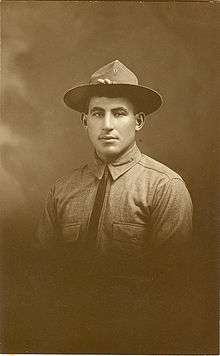William Shemin
| William Shemin | |
|---|---|
 | |
| Born |
October 14, 1896 Bayonne, New Jersey |
| Died |
August 15, 1973 (aged 76) New York City |
| Place of burial | Baron Hirsch Cemetery |
| Allegiance | United States of America |
| Service/branch | United States Army |
| Years of service | 1917 - 1919 |
| Rank | Sergeant |
| Unit | Company G, 47th Infantry Regiment, 4th Infantry Division |
| Battles/wars | |
| Awards |
|
William Shemin (October 14, 1896 – August 15, 1973) was a Sergeant in the U.S. Army during World War I. He was posthumously awarded the Medal of Honor for bravery in action in Vesle River, near Bazoches, France. On June 2, 2015, Elsie Shemin-Roth and her sister Ina Bass accepted the nation's highest military award for valor on behalf of her father from President Barack Obama at the White House. Shemin was assigned to Company G, 47th Infantry Regiment, 4th Infantry Division, American Expeditionary Force.
Biography
William Shemin was born in Bayonne, New Jersey. During his teenage years, he played semi-pro baseball. He graduated from the New York State Ranger School in 1914, and went on to work as a forester in Bayonne. Shemin enlisted in the Army, October 2, 1917. Upon completion of basic training at Camp Greene, North Carolina, he was assigned as a rifleman to Company G, 47th Infantry Regiment, 4th Infantry Division, American Expeditionary Forces, in France
Shemin participated in the Aisne-Marne Offensive, where he took shrapnel and was wounded by a machine gun bullet that pierced his helmet and was lodged behind his left ear. Following his injuries, Shemin was hospitalized for three months and later received light duty as part of the Army occupation in Germany and Belgium until he completed his tour. Shemin received the Purple Heart for his injuries during combat. He was awarded the Distinguished Service Cross for battlefield valor in December 19, 1919.
While serving as a rifleman from August 7-9, 1918, Shemin left the cover of his platoon's trench and crossed open space, repeatedly exposing himself to heavy machine gun and rifle fire to rescue the wounded. After officers and senior non-commissioned officers had become casualties, Shemin took command of the platoon and displayed great initiative under fire, until he was wounded on August 9.
Shemin was honorably discharged in August 1919, and went on to get a degree from the New York State College of Forestry at Syracuse University. After graduation, he started a greenhouse and landscaping business in Bronx, New York, where he raised three children. Shemin died in 1973.
" With the most utter disregard for his own safety, (Shemin) sprang from his position in his platoon trench, dashed out across the open in full sight of the Germans, who opened and maintained a furious burst of machine gun and rifle fire."— Capt. Rupert Purdon, one of Shemin's superiors.
Medal of Honor Citation
The President of the United States of America, authorized by Act of Congress, March 3, 1863, has awarded in the name of Congress the Medal of Honor to:
SERGEANT WILLIAM SHEMIN
United States ArmyFor conspicuous gallantry and intrepidity at the risk of his life above and beyond the call of duty:
Sergeant Shemin distinguished himself by acts of gallantry and intrepidity above and beyond the call of duty while serving as a Rifleman with G Company, 2d Battalion, 47th Infantry Regiment, 4th Division, American Expeditionary Forces, in connection with combat operations against an armed enemy on the Vesle River, near Bazoches, France from August 7 to August 9, 1918. Sergeant Shemin left cover and crossed open space, repeatedly exposing himself to heavy machine-gun and rifle fire, to rescue wounded. After Officers and Senior Noncommissioned Officers had become casualties, Sergeant Shemin took command of the platoon and displayed great initiative under fire until wounded on August 9. Sergeant Shemin’s extraordinary heroism and selflessness, above and beyond the call of duty, are in keeping with the highest traditions of the military service and reflect great credit upon himself, his unit, and the United States Army.
References
- "United States Army. Medal of Honor: Sergeant William Shemin". Retrieved 2015-06-13.
 This article incorporates public domain material from websites or documents of the United States Army Center of Military History.
This article incorporates public domain material from websites or documents of the United States Army Center of Military History.
